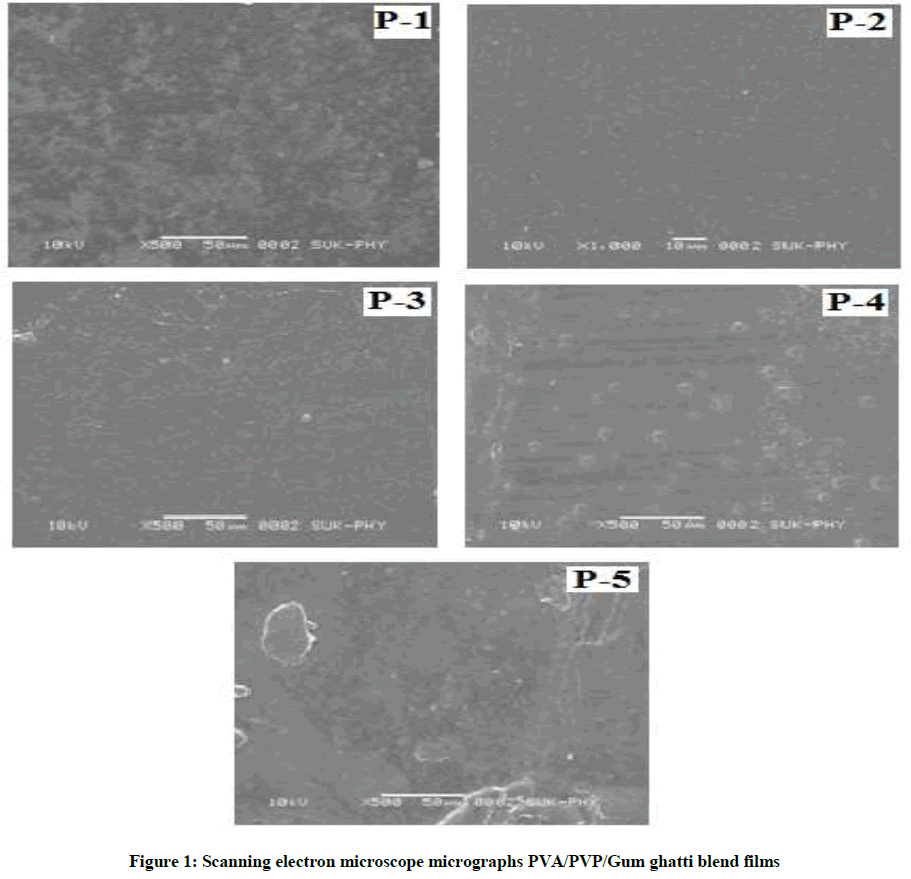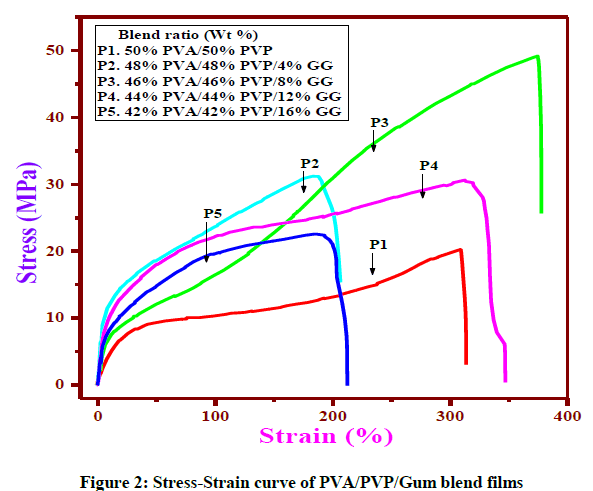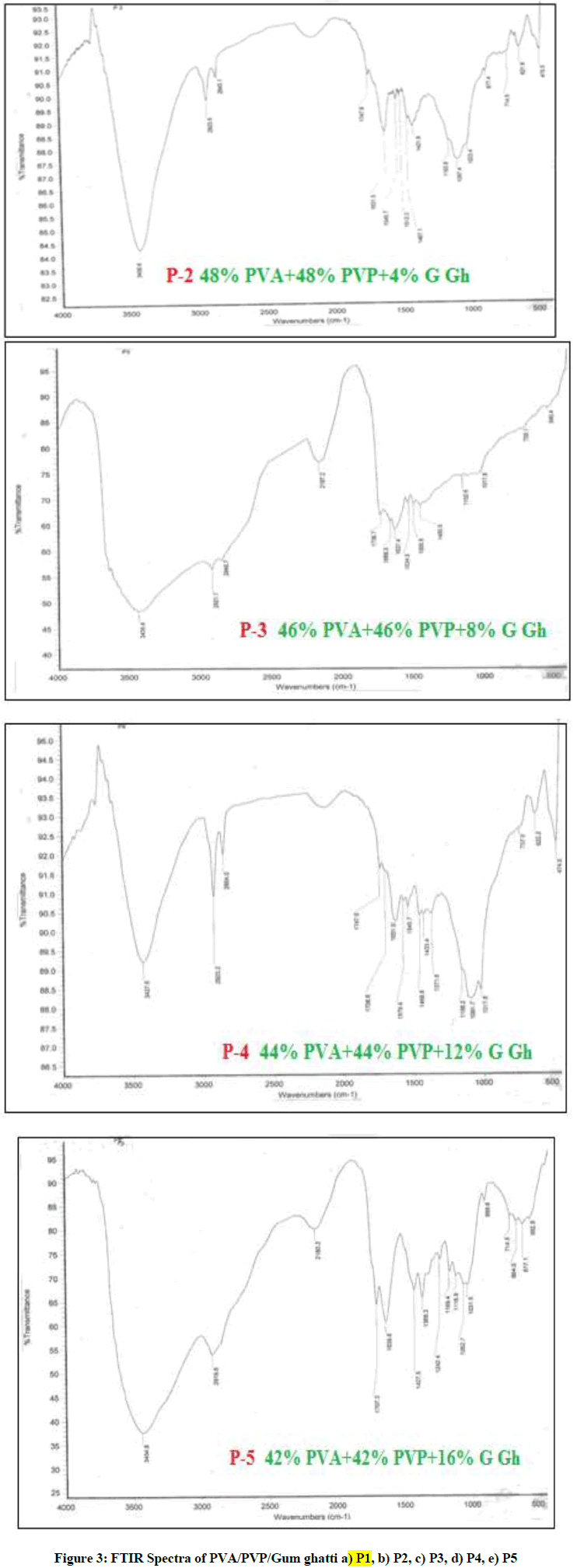Research Article - Der Pharma Chemica ( 2018) Volume 10, Issue 1
Influence of Gum Ghatti on Morphological and Mechanical Properties of Poly(vinylalcohol)/Poly(vinyl pyrrolidone) Blend Films
Ravindra B Chougale1*, Saraswati P Masti2, Deepak R Kasai3 and Bhagyavana S Mudigoudra4
1P.G. Department of Studies in Chemistry, Karnatak University, Dharwad-580 003, Karnataka, India
2Department of Chemistry, Karnatak Science College, Dharwad-580 001, Karnataka, India
3Department of Materials Science, Mangalore University, Mangalgangotri-574 199, Karnataka, India
4Department of Computer Science, Maharani Science College for Women, Bangalore, Karnataka, India
- Corresponding Author:
- Ravindra B Chougale
P.G. Department of Studies in Chemistry
Karnatak University, Dharwad-580 003, Karnataka, India
Abstract
In the present study, different weight percent of gum ghatti doped poly (vinyl alcohol)/poly (vinyl pyrrolidone) blend films were prepared by solution blending and solvent evaporating technique. The prepared blend films were analyzed for phase morphology and mechanical properties. Different weight percent (wt%) of gum ghatti incorporated blend films were evaluated by using Scanning Electron Microscope (SEM) and Universal Testing Machine (UTM). SEM micrographs of the blend system showed initially good miscibility and homogeneous phase morphology but higher weight percent of gum ghatti presented heterogeneous phase morphology. The results of mechanical properties showed increased tensile strength, young’s modulus and elongation at break. The Fourier Transform Infra-Red (FTIR) study confirmed that strong interaction between each blend components, indicating the formation of cross link and intermolecular interaction in the blend films.
Keywords
PVA, PVP, Gum ghatti, Mechanical, Morphology
Introduction
Nowadays, there is an increasing interest towards the development of natural and biodegradable polymers [1] which have been studied as a potential packaging material having good mechanical and novelistic properties [2]. Certainly for some foods like fresh foods, biodegradable polymers were more suitable [3-6]. In this context gums are important families of natural polymers derived from the seeds or tubers of plants. Among natural gums, gum ghatti is a promising polysaccharide [7]. Gum ghatti is a unique, non-starch polysaccharide much accepted for its excellent emulsification property. Gum ghatti is an extremely complex polysaccharide that occurs in nature as mixed calcium and magnesium salts of uronic acid or ghattic acid. It has also been reported to have approximately 3% protein. Poly (vinyl alcohol) is a non-toxic, water soluble, biocompatible, better film and fiber forming, biodegradable synthetic polymer which is widely used in the biomedical field [8]. Poly(vinyl alcohol) is widely used in blending due to the presence of –OH- groups and the hydrogen bond formation. Poly(vinyl pyrrolidone) is an amorphous and important water soluble synthetic polymer. It is widely used in biomedical field because of low toxicity and highly soluble in water [9]. The aim of the study is to prepare gum ghatti doped PVA/PVP ternary blend films and evaluate the influence of gum ghatti on morphological and mechanical properties blend films.
Materials and Methods
Poly (vinyl alcohol), molecular weight 1,40,000 and poly(vinyl pyrrolidone) average weight, 40,000 were procured from, Himedia, Mumbai and were used as received. Similarly, gum ghatti was also purchased from Himedia, Mumbai. Doubly distilled water was used throughout the experiment.
Preparation of blend films
Ternary polymer blends films of poly (vinyl alcohol)/poly (vinyl pyrrolidone)/gum ghatti of different compositions were prepared by solvent casting method. For the preparation of blend films, exactly weighed amount of two different polymers and gum ghatti were dissolved separately in respective solvent. After allowing them to dissolve completely, the three solutions were mixed with continuous stirring on magnetic stirrer for 4 h. Subsequently definite volume of homogeneous solutions poured onto previously cleaned and dried glass petri dishes and solvent was evaporated at room temperature to form blend films. The composition of the blend films were presented in Table 1.
| S. No. | Blend composition PVA/PVP/Gum ghatti (Wt %) | Sample code | PVA (Wt %) | PVP (Wt %) | Gum ghatti (Wt %) |
|---|---|---|---|---|---|
| 1 | 50/50/0.0 | P-1 | 50 | 50 | 0 |
| 2 | 48/48/4 | P-2 | 48 | 48 | 4 |
| 3 | 46/46/8 | P-3 | 46 | 46 | 8 |
| 4 | 44/44/12 | P-4 | 44 | 44 | 12 |
| 5 | 42/42/16 | P-5 | 42 | 42 | 16 |
Table 1: The composition of ternary blend films
Characterization
Scanning electron microscopy-Phase morphology of blend films was investigated by using Scanning Electron Microscopy (SEM) (JOEL-JSM- 6360, Germany). Prior to the examination, blend films were dried overnight in a hot air oven at 45°C. Films were sputter coated with gold to avoid charging under high electron beam and mounted on a metal stub with double side sticky tape. The images were taken at accelerating voltage 5 kV and a magnification 500 times of origin specimen size. The sample must be free from H2O as the electrons expelled from the electron gun would vaporize the sample which would have an impact on the micrograph obtained.
Mechanical properties-The mechanical properties of the blend films were investigated by using A Lloyd Universal testing machine (Lloyds-5 KN, London, UK) according to ASTM D-882 standard test (ASTM, 1992) at room temperature in air. Rectangular shaped films samples (25 × 100 mm) were taken for the determination of mechanical properties. Two metallic grips were attached for griping both ends of the test specimen of the film. The lower grip was stationary and the upper grip moved upward with constant rate of extension 50 mm/min keeping constant initial grip separation 50 mm for all samples. An automatic speed controller was attached to keep the speed of the upper grip. The machine was electrically driven. Stress-strain curves were plotted for each blend. Tensile strength, young’s modulus, percent (%) elongation at break were calculated using NEXYGEN Plus software.
Fourier Transform Infrared (FTIR) spectroscopy, in order to understand the possible interactions among the PVA, PVP and gum ghatti in blend systems, films were subjected to the FTIR spectroscopy. FTIR spectra of the blend films were recorded using an Attenuated Total Reflection (ATR) method in IR spectrometer (FTIR-ATR, Prestage 21, Shimadzu, Japan). Samples were analyzed between 400 and 4000 cm-1 with a resolution of 4 cm-1.
Results and Discussions
Scanning Electron Microscopy (SEM)-The surface morphology of PVA/PVP/Gum Ghatti blend films were analyzed by using JOEL-JSM-6360, electron microscope (Germany). Figure 1 shows scanning electron microscope micrographs of the top surface of the PVA/PVP blend film and PVA/PVP/Gum ghatti blended films. SEM micrograph indicated that on the surface of PVA/PVP blend films, many non-spherical granules with varying size granules were observed.
The different weight percent of (4 wt%, 8 wt% and 12 wt%) gum ghatti doped PVA/PVP blend films presented significant changes and disappearance of such granules like structures were observed. Initially lower weight percent of gum ghatti showed clear homogenous phase morphology indicating the complete miscibility. This could be attributed to the strong interactions between blend components through hydrogen bonding and cross linking confirmed by the FTIR study. As the concentration of gum ghatti increased in the PVA/PVP blend films especially in 16 wt % and 20 wt % gum ghatti showed a little rougher surface.
Also the higher concentration of gum ghatti in PVA/PVP blend films affected the internal phase morphology due to aggregation of gum ghatti causing the rough, hard, and brittleness in the film. Such a rough surface could be due to the reorientation of polar functional groups towards the top surface of the blend film. Based on these observations it can be concluded that the lower concentration of gum ghatti in PVA/PVP blend films up to 12% are not showing any difficulty. But as the concentration of gum ghatti increased in the films, compatible decreased slightly exhibiting heterogeneous phase morphology.
Mechanical properties
The mechanical properties of blend films were investigated by using A Lloyd LRX plus universal testing machine. The stress- strain curve for tensile strength, young’s modulus and the % elongation at break is demonstrated in Figure 2. The tensile strength, young’s modulus and the % elongation is summarized in Table 2.
| S. No. | Blend composition PVA/PVP/ gum ghatti | Tensile strength (MPa) | Young’s Modulus (MPa) | Elongation at Break (%) |
|---|---|---|---|---|
| 1 | 50/50/0.0 | 20.26 | 54.33 | 308.90 |
| 2 | 48/48/4 | 31.20 | 297.4 | 206.55 |
| 3 | 46/46/8 | 49.16 | 95.25 | 373.24 |
| 4 | 44/44/12 | 30.63 | 241.5 | 333.82 |
| 5 | 42/42/16 | 22.56 | 199.8 | 212.17 |
Table 2: Tensile Properties of PVA/PVP/Gum ghatti blend films
The results mechanical study indicated that an initially mechanical property including tensile strength (Ts), young’s modulus (Ym) and Percent of elongation at break (%Eb) increased significantly (20.26 MPa to 49.16 MPa). Then as the concentration (wt %) of gum ghatti increases, mechanical properties showed descending order. In the ternary blend films, mechanical properties increased upto 8% gum ghatti and above this wt %, properties were decreased slightly. This may be due to weak interfacial adhesion among the blend components at higher weight percent of gum ghatti. Overall there is increase mechanical properties were observed with addition of different weight percent of gum ghatti onto the PVA/PVP blend films. This could be due to the strong interaction between PVA, PVP and gum ghatti. The interesting fact, with addition of gum ghatti percent og elongation has increased significantly compared to the PVA/PVP blend films. The maximum % Eb was observed for the composition 46/46/8 and 44/44/12. The stress-strain curve shows that there is a gradual transition from elastic to plastic nature as the gum ghatti content increases from 12 to 16 wt %.
FT-IR Spectroscopy (FT-IR)-PVA/PVP and gum ghatti doped PVA/PVP blend films were characterized by the Fourier transform infrared and spectral data are shown in Figure 3 and Tables 3, 4. The prepared blend film showed broad absorption band at 3427 cm-1 to 3435 cm-1 which appeared peak at 3446.56 cm-1 is attributed to the presence of a hydroxyl group that is due to the hydrogen bonding to various degrees.
| Pure poly(vinyl pyrrolidone) | Pure poly(vinyl alcohol) | Pure blend poly(vinyl alcohol)//Poly (vinyl pyrrolidone) | |||
|---|---|---|---|---|---|
| Wave number (cm-1) | Assignment | Wave number (cm-1) | Assignment | Wave number (cm-1) | Assignment |
| 3423 | O-H Stretching | 3455 | O-H Stretching | 3431 | O-H Stretching of alcohols |
| 2924 | CH2 Asymmetric stretching | 2924 | CH2 Asymmetric stretching | 2924 | CH2 Asymmetric stretching |
| 2854 | CH2 symmetric stretching | 2892 | CH2 symmetric stretching | 2854 | CH2 symmetric stretching |
| 1744 | C = O Stretching | 1664 | C = C Stretching | 1629 | C = C Stretching |
| 1644 | C = C Stretching | 1461 | CH2 bending | 1744 | C = O Stretching |
| 1565 | O-H and C-H bending | 962 | C-H out of plane bending | 1630 | O-H and C-H bending |
| 1450 | O-H and C-H bending | - | - | 1459 | C = N (Pyrrolidone ring) |
| 1340 | CH2 out of plane bending | - | - | 1020 | out of plane rings C – H bending |
| 1161 | CH wagging | - | - | - | - |
| 1115 | C-OC stretching | - | - | - | - |
| 1022 | CO symmetric stretching | - | - | - | - |
| 720 | CH2 rocking | - | - | - | - |
Table 3: Assignments of the FTIR characterization PVA, PVP and PVA/PV
| Pure Gum Ghatti | Poly(vinyl alcohol)/Poly(vinyl pyrrolidone) + Gum ghatti | ||
|---|---|---|---|
| Wave Number (cm-1) | Assignment | Wave number (cm-1) | Assignment |
| 3434 (cm-1) and 1032 cm-1 | Characteristics of saccharide structure (due to Hydroxyl group stretching) | 3427-3435 | broad band which appeared at 3446.56 cm-1 is attributed to the presence of a hydroxyl group that is hydrogen bonded to various degrees |
| 2925 (cm-1) | Stretching vibration of –CH group | Around 2924 | Broad band appearance indicate the increase in stretching vibration of –CH group |
| 1622 (cm-1) | Stretching vibration of carbonyl group | Around 1631 | Peak indicate the vibration of carbonyl group with hydrogen bonding |
| 1247.86 (cm-1) | presence of a C-O-C group |
1076 (cm-1) | Indicates the C-O stretching vibration among the Hydroxyl group of gum ghatti and PVA |
| 1421 (cm-1) | Characteristic peak due to OH Bending | ||
| Around 1371 | C = C Pyrolidine ring | ||
| 877-911 | C – O stretching | ||
| 474-562 | C = C Stretching | ||
Table 4: Assignments of the FTIR characterization PVA/PVP/Gum ghatti blend
The characteristic band appeared at 1631 cm-1 and 1421 cm-1 can be attributed to the -OH bending of gum ghatti which is not present in poly(vinyl alcohol)/poly(vinyl pyrrolidone) binary blend film. The main characteristic band appeared in the PVA/PVP/gum ghatti ternary blend films confirms the cross linking and intermolecular interaction between –OH group of poly (vinyl alcohol), C = O group of poly(vinyl pyrrolidone). The result of FTIR study confirms that hydroxyl and C = O group of gum ghatti which are responsible for homogeneous single phase morphology with increased mechanical properties in the blend films.
Conclusion
In the present work, ternary blend films of gum ghatti doped PVA/PVP blend films were prepared successfully using solvent evaporating technique. The result of SEM micrographs confirmed that gum ghatti completely miscible at lower weight percent. Meanwhile disappearance of non-spherical granules in the PVA/PVP/gum ghatti blend films suggested the compatibility of the blend components. Addition of gum ghatti at lower weight percent lead to the complete miscible blend films with increased mechanical properties confirmed by the UTM results. Higher weight percent of gum ghatti created aggregation in the PVA/PVP films leading to the heterogeneous phase morphology. Based on mechanical study it is clear that, blend film shows maximum tensile strength and elongation at break for 8 wt % and then decreases for 12 and 16 wt % of gum ghatti, indicates that excess of gum ghatti added leads to immiscibility and films becomes hard and brittle. The infrared spectra confirms the cross linking and intermolecular interaction between –OH group of PVA, C = O group of PVP and hydroxyl and C = O group of gum ghatti which is responsible for clear homogeneous single phase morphology.
References
- J.S. Boateng, K.H. Matthews, H.N. Stevens, G.M. Eccleston, J. Pharm. Sci., 2008, 97, 2892-2923.
- K. Denniston, R. Caret, J. Topping, General, Organic and Biochemistry, 6th Ed., McGraw-Hill Science, New York, 2007, 928.
- F.E. Ehivet, B. Min, M.K. Park, J.H. Oh, J. Food Sci., 2011, 7(1), C178-C18476.
- V. Siracusa, P. Rocculi, S. Romani, M.D. Rosa, Trends Food Sci. Technol., 2008, 19(2), 634-643.
- C.N. Cutter, Meat Sci., 2006, 74(1), 131-142.
- S. Imam, G. Glenn, B.S. Chiou, J. Shey, R. Narayan, W. Orts, Types, Production and Assessment of Biobased Food Packaging Materials, Food Packaging, Woodhead Publishing, Cambridge, UK, In: E. Chiellini (Ed.), Environmentally Compatible, 2008, 29-62.
- A.A.A. De Queiroz, D.T.A.W. Soares, P. Trzesniak, G.A. Abraham, J. Polym. Sci. Part B: Polym. Phys.,2001, 39(4), 459-469.
- J.S. Lee, K.H. Choi, H.D. Ghim, J. Appl. Polym. Sci., 2004, 93(4), 1638-1646.
- D. Li, Y.N. Xia, Adv. Mat., 2004, 16(14), 1151-1170.






